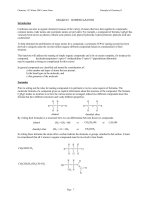Principles of green chemistry
Bạn đang xem bản rút gọn của tài liệu. Xem và tải ngay bản đầy đủ của tài liệu tại đây (1.41 MB, 54 trang )
Is Sustainable Energy Development
Possible?
(It’s Not Easy Being Green)
Professor Thomas R. Marrero Ornés
University of Missouri-Columbia
Allen, D.T. and Shonnard, D.R., 2002, Green Engineering:
Environmentally Conscious Design of Chemical Processes,
Prentice-Hall, p. 65
Figure 1
The Pollution Prevention Act (PPA) states:
1. Pollution should be prevented or reduced at the
source whenever feasible
2. Pollution that cannot be prevented or reduced
should be recycled
3. Pollution that cannot be prevented or reduced or
recycled should be treated, and
4. Disposal or other releases into the environment
should be employed only as a last resort.
Principles of Green Chemistry
Anastas, Paul T.; Warner, John C.
Green Chemistry Theory and Practice;
Oxford University Press: New York, 1998
Definition of Green Chemistry
“The design of chemical products and
processes that are more environmentally
benign and reduce negative impacts to
human health and the environment.”
12 Principles of Green Chemistry
1. It is better to prevent waste than to treat or
clean up waste after it is formed.
2. Synthetic methods should be designed to
maximize the incorporation of all materials
used in the process into the final product.
12 Principles of Green Chemistry
3. Wherever practicable, synthetic
methodologies should be designed to use
and generate substances that possess little or
no toxicity to human health and the
environment.
4. Chemical products should be designed to
preserve efficacy of function while reducing
toxicity.
12 Principles of Green Chemistry
5. The use of auxiliary substances (solvents,
separation agents, etc.) should be made
unnecessary whenever possible and, when
used, innocuous.
6. Energy requirements should be recognized for
their environmental and economic impacts and
should be minimized. Synthetic methods should
be conducted at ambient temperature and
pressure.
12 Principles of Green Chemistry
7. A raw material or feedstock should be
renewable rather than depleting whenever
technically and economically practical.
8. Unnecessary derivatization (blocking group,
protection/deprotection, temporary
modification of physical/chemical processes)
should be avoided whenever possible.
12 Principles of Green Chemistry
9. Catalytic reagents (as selective as possible)
are superior to stoichiometric reagents.
10. Chemical products would be designed so
that at the end of their function they do not
persist in the environment and instead
break down into innocuous degradation
products.
12 Principles of Green Chemistry
11. Analytical methodologies need to be further
developed to allow for real-time in-process
monitoring and control prior to the formation
of hazardous substances.
12. Substances and the form of a substance used
in a chemical process should be chosen so as to
minimize the potential for chemical accidents,
including releases, explosions, and fires.
12 Additional Principles for
Green Chemistry.
Gonzales, M.A., and R. L. Smith, 2003
Environ. Prog. 22, 269
12 Additional Principles for Green
Chemistry.
1. Identify byproducts; quantify if possible
2. Report conversions, selectivities, and
productivities
3. Establish a full mass balance for the process
4. Quantify catalyst and solvent losses
12 Additional Principles for Green
Chemistry.
5. Investigate basic thermochemistry to
identify exotherms (safety)
6. Anticipate other potential mass and energy
transfer limitations
7. Consult a chemical or process engineer
12 Additional Principles for Green
Chemistry.
8. Consider the effect of the overall process on
choice of chemistry
9. Help develop and apply sustainable
measures
10. Quantify and minimize use of utilities and
other inputs
12 Additional Principles for Green
Chemistry.
11. Recognize where operator safety and waste
minimization may be compatible
12. Monitor, report and minimize wastes
emitted to air, water, and solids from
experiments or processes
Definition of Green Engineering
Abraham, M., 2004, Environ. Prog. 23 (4), p. 266.
“The design, commercialization, and use of
processes and products, which are feasible
and economical while minimizing (1)
generation of pollution at the source and (2)
risk to human health and the environment.”
12 Principles of Green Engineering
Anastas, P. and J.B. Zimmerman, Environ. Sci. Techol., vol 37 (5), p. 95A.
1. Designers need to strive to ensure that all
material and energy inputs and outputs are
as inherently nonhazardous as possible.
2. It is better to prevent waste than to treat or
clean up waste after it is formed.
12 Principles of Green Engineering
3. Separation and purification operations
should be designed to minimize energy
consumption and materials use.
4. Products, processes, and systems should be
designed to maximize mass, energy, space,
and time efficiency.
12 Principles of Green Engineering
5. Products, processes, and systems should be
“output pulled” rather than “input pushed”
through the use of energy and materials.
6. Embedded entropy and complexity must be
viewed as an investment when making
design choices on recycle, reuse, or beneficial
disposition.
12 Principles of Green Engineering
7. Targeted durability, not immortality, should
be a design goal.
8. Design for unnecessary capacity or capability
(e.g., “one size fits all”) solutions should be
considered a design flaw.
12 Principles of Green Engineering
9. Material diversity in multicomponent
products should be minimized to promote
disassembly and value retention.
10. Design of products, processes, and systems
must include integration and
interconnectivity with available energy and
materials flows.
12 Principles of Green Engineering
11. Products, processes, and systems should be
designed for performance in a commercial
“afterlife”.
12. Material and energy inputs should be
renewable rather than depleting.
Sandestin Declaration of Green
Engineering Principles
To fully implement Green Engineering solutions,
engineers use the following principles:
1. Engineer processes and products holistically, use
systems analysis, and integrate environmental
impact assessment tools
2. Conserve and improve natural ecosystems while
protecting human health and well-being
Sandestin Declaration of Green
Engineering Principles
3. Use life cycle thinking in all engineering
activities
4. Ensure that all material and energy inputs
and outputs are as inherently safe and
benign as possible
5. Minimize depletion of natural resources









